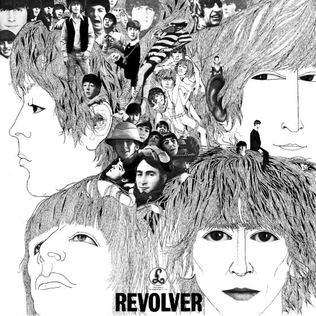
Revolver is the seventh studio album by the English rock band the Beatles. It was released on 5 August 1966, accompanied by the double A-side single "Eleanor Rigby" / "Yellow Submarine". The album was the Beatles' final recording project before their retirement as live performers and marked the group's most overt use of studio technology to date, building on the advances of their late 1965 release Rubber Soul. It has since become regarded as one of the greatest and most innovative albums in the history of popular music, with recognition centred on its range of musical styles, diverse sounds and lyrical content.

A recording studio is a specialized facility for recording and mixing of instrumental or vocal musical performances, spoken words, and other sounds. They range in size from a small in-home project studio large enough to record a single singer-guitarist, to a large building with space for a full orchestra of 100 or more musicians. Ideally, both the recording and monitoring spaces are specially designed by an acoustician or audio engineer to achieve optimum acoustic properties.

Multitrack recording (MTR), also known as multitracking, is a method of sound recording developed in 1955 that allows for the separate recording of multiple sound sources or of sound sources recorded at different times to create a cohesive whole. Multitracking became possible in the mid-1950s when the idea of simultaneously recording different audio channels to separate discrete tracks on the same reel-to-reel tape was developed. A track was simply a different channel recorded to its own discrete area on the tape whereby their relative sequence of recorded events would be preserved, and playback would be simultaneous or synchronized.
Flanging is an audio effect produced by mixing two identical signals together, one signal delayed by a small and (usually) gradually changing period, usually smaller than 20 milliseconds. This produces a swept comb filter effect: peaks and notches are produced in the resulting frequency spectrum, related to each other in a linear harmonic series. Varying the time delay causes these to sweep up and down the frequency spectrum. A flanger is an effects unit that creates this effect.

"Let It Be" is a song by the English rock band the Beatles, released on 6 March 1970 as a single, and as the title track of their album Let It Be. It was written and sung by Paul McCartney, and credited to the Lennon–McCartney partnership. The single version of the song, produced by George Martin, features a softer guitar solo and the orchestral section mixed low, compared with the album version, produced by Phil Spector, featuring a more aggressive guitar solo and the orchestral sections mixed higher.
Automatic double-tracking or artificial double-tracking (ADT) is an analogue recording technique designed to enhance the sound of voices or instruments during the mixing process. It uses tape delay to create a delayed copy of an audio signal which is then played back at slightly varying speed controlled by an oscillator and combined with the original. The effect is intended to simulate the sound of the natural doubling of voices or instruments achieved by double tracking. The technique was developed in 1966 by engineers at Abbey Road Studios in London at the request of the Beatles.

"Real Love" is a song written by the English musician John Lennon, formerly of the Beatles. He recorded six demos of the song in 1979 and 1980 with "Real Life", a different song that merged with "Real Love". In 1988, the sixth take was posthumously released for the documentary soundtrack Imagine: John Lennon. In 1995, his demo was completed by his former Beatles bandmates as part of the Beatles Anthology project, along with "Free as a Bird".

"Instant Karma!" is a song by English rock musician John Lennon, released as a single on Apple Records in February 1970. The lyrics focus on a concept in which the consequences of one's actions are immediate rather than borne out over a lifetime. The single was credited to "Lennon/Ono with the Plastic Ono Band", apart from in the US, where the credit was "John Ono Lennon". The song reached the top five in the British and American charts, competing with the Beatles' "Let It Be" in the US, where it became the first solo single by a member of the band to sell a million copies.
Overdubbing is a technique used in audio recording in which audio tracks that have been pre-recorded are then played back and monitored, while simultaneously recording new, doubled, or augmented tracks onto one or more available tracks of a digital audio workstation (DAW) or tape recorder. The overdub process can be repeated multiple times. This technique is often used with singers, as well as with instruments, or ensembles/orchestras. Overdubbing is typically done for the purpose of adding richness and complexity to the original recording. For example, if there are only one or two artists involved in the recording process, overdubbing can give the effect of sounding like many performers.
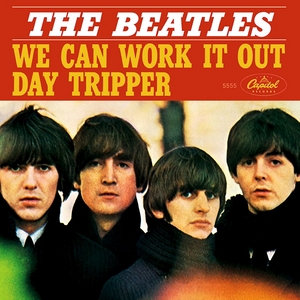
"Day Tripper" is a song by the English rock band the Beatles that was released as a double A-side single with "We Can Work It Out" in December 1965. The song was written primarily by John Lennon with some contributions from Paul McCartney and was credited to the Lennon–McCartney partnership. Both songs were recorded during the sessions for the band's Rubber Soul album. The single topped charts in Britain, Ireland, the Netherlands and Norway. In the United States, "Day Tripper" peaked at number five on the Billboard Hot 100 chart and "We Can Work It Out" held the top position.
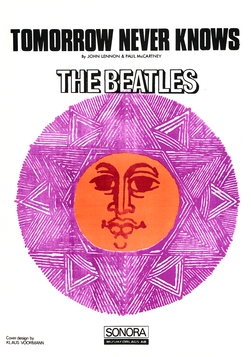
"Tomorrow Never Knows" is a song by the English rock band the Beatles, written primarily by John Lennon and credited to Lennon–McCartney. It was released in August 1966 as the final track on their album Revolver, although it was the first song recorded for the LP. The song marked a radical departure for the Beatles, as the band fully embraced the potential of the recording studio without consideration for reproducing the results in concert.
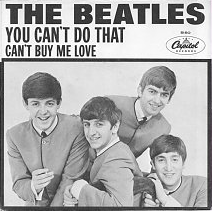
"You Can't Do That" is a song written by John Lennon and released by the English rock band the Beatles as the B-side of their sixth British single "Can't Buy Me Love". It was later released on their third UK album A Hard Day's Night (1964). A live rendition of the song was released on the 2016 re-release of The Beatles at the Hollywood Bowl.
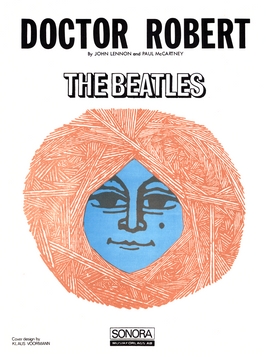
"Doctor Robert" is a song by the English rock band the Beatles. It was released in 1966 on their album Revolver, apart from in North America, where it instead appeared on their Yesterday and Today album. The song was written by John Lennon, although Paul McCartney has said that he co-wrote it. The Beatles recorded the track in seven takes on 17 April 1966, with vocals overdubbed on 19 April.
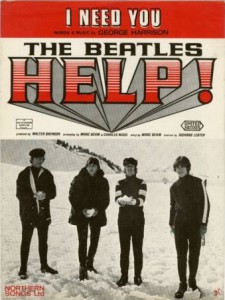
"I Need You" is a song by the English rock band the Beatles from their 1965 album Help! It was written by George Harrison, the group's lead guitarist, and was the second composition of his to be released by the Beatles. The track appears in their film Help!, in a scene filmed on Salisbury Plain where the group were under military protection from a murderous cult.
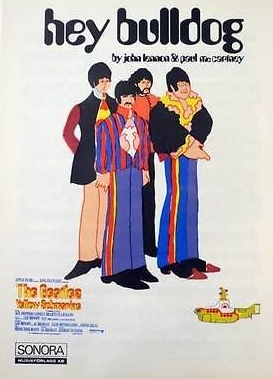
"Hey Bulldog" is a song by the English rock band the Beatles released on their 1969 soundtrack album Yellow Submarine. Credited to Lennon–McCartney, but written primarily by John Lennon, it was finished in the recording studio by both Lennon and Paul McCartney. The song was recorded during the filming of the "Lady Madonna" promotional film, and, with "Lady Madonna", is one of the few Beatles songs based on a piano riff.

"Baby, You're a Rich Man" is a song by the English rock band the Beatles that was released as the B-side of their "All You Need Is Love" single in July 1967. It originated from an unfinished song by John Lennon, titled "One of the Beautiful People", to which Paul McCartney added a chorus. It is one of the best-known pop songs to make use of a clavioline, a monophonic keyboard instrument that was a forerunner to the synthesizer. Lennon played the clavioline on its oboe setting, creating a sound that suggests an Indian shehnai. The song was recorded and mixed at Olympic Sound Studios in London, making it the first of the Beatles' EMI recordings to be entirely created outside EMI Studios.

The studio practices of the Beatles evolved during the 1960s and, in some cases, influenced the way popular music was recorded. Some of the effects they employed were sampling, artificial double tracking (ADT) and the elaborate use of multitrack recording machines. They also used classical instruments on their recordings and guitar feedback. The group's attitude towards the recording process was summed up by Paul McCartney: "We would say, 'Try it. Just try it for us. If it sounds crappy, OK, we'll lose it. But it might just sound good.' We were always pushing ahead: Louder, further, longer, more, different."

Multitrack recording of sound is the process in which sound and other electro-acoustic signals are captured on a recording medium such as magnetic tape, which is divided into two or more audio tracks that run parallel with each other. Because they are carried on the same medium, the tracks stay in perfect synchronization, while allowing multiple sound sources to be recorded at different times.
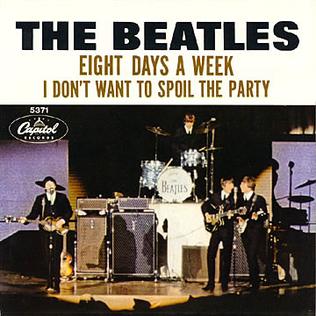
"Eight Days a Week" is a song by the English rock band the Beatles. It was written by Paul McCartney and John Lennon based on McCartney's original idea. The song was released in the United Kingdom in December 1964 on the album Beatles for Sale. In the United States, it was first issued as a single in February 1965 before appearing on the North American release Beatles VI. The song was the band's seventh number 1 single on the Billboard Hot 100, a run of US chart success achieved in just over a year. The single was also number 1 in Canada, Belgium and the Netherlands.
Send tape echo echo delay is a technique used in magnetic tape sound recording to apply a delay effect using tape loops and echo chambers.













